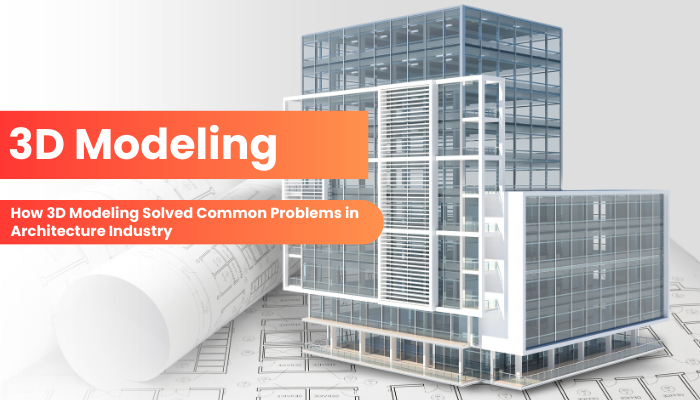In recent years, the architectural world has undergone a profound transformation, largely thanks to advances in 3D modeling. This technology has revolutionized the way architects and designers approach projects, helping to solve many of the challenges that have traditionally plagued the industry. Whether it’s enhancing design accuracy or improving collaboration among stakeholders, 3D modeling services have had a massive impact. In this article,
we’ll explore how 3D modeling has addressed common problems in architecture, with a special focus on its role in architecture both globally and in 3D modeling India.
Enhanced Visualization and Conceptualization
The Power of Realistic 3D Rendering
Before the advent of 3D modeling, architects relied heavily on 2D blueprints and sketches, which often left clients struggling to visualize the final outcome of a project. One of the most significant advantages of 3D modeling services is the ability to create realistic, detailed renderings that allow both architects and clients to better understand how a finished building will look and function. This enhanced visualization has become particularly critical in the design phase, making it easier to communicate complex ideas.
For example, in large-scale projects like urban planning or multi-story commercial buildings, 3D modeling India has become a powerful tool for transforming rough ideas into visually compelling presentations.
Whether it’s creating virtual tours of proposed spaces or experimenting with different design elements in real-time, 3D modeling allows for faster revisions and more informed decision-making.
Bridging the Gap Between Clients and Architects
Clients often find it difficult to interpret technical plans, leading to misunderstandings about the final product. 3D modeling helps bridge this gap by offering a realistic, immersive experience of the proposed design, allowing clients to “walk through” the building before it is constructed. This not only improves communication but also helps avoid costly changes down the line by ensuring everyone involved shares a clear vision from the outset.
Improved Accuracy and Precision
Reducing Design Errors and Revisions
In the past, one of the most significant challenges in architecture was the high potential for design errors. Even minor mistakes in 2D plans could lead to significant delays and cost overruns during construction. 3D modeling services help solve this issue by providing an accurate, comprehensive view of every aspect of a building’s design, from structural integrity to electrical and plumbing systems.
Thanks to the detailed nature of 3D modeling, architects can detect potential problems early in the design phase, minimizing the risk of errors later on. This has become particularly important in projects requiring a high degree of precision, such as healthcare facilities or research labs.
By identifying clashes or inconsistencies before construction begins, 3D modeling reduces the need for revisions and redesigns, saving both time and money.
Enhanced Collaboration with Engineers
Another common issue in architecture is the difficulty of coordinating between different teams, such as architects, engineers, and contractors. 3D modeling streamlines this collaboration by creating a unified platform where everyone can work together to refine the design. Engineers can easily review the structural, mechanical, and electrical aspects of a building, while contractors can better plan construction timelines and material needs.
In 3D modeling India, this integrated approach is becoming increasingly popular in large infrastructure projects, where precise coordination between teams is critical to success.
By improving communication and collaboration, 3D modeling services help ensure that everyone involved in a project is on the same page, reducing misunderstandings and project delays.
Time and Cost Efficiency
Faster Iteration and Prototyping
One of the most time-consuming aspects of architectural design has always been the need for multiple iterations and prototypes. Traditional methods of revising designs could take weeks or even months, especially for large or complex projects. 3D modeling has significantly sped up this process by allowing architects to make changes quickly and efficiently.
With 3D modeling services, design adjustments can be made in real-time, and new renderings or virtual tours can be produced almost instantly. This not only accelerates the design process but also allows architects to explore a wider range of design options without adding significant time or cost to the project.
Reducing Construction Costs
Another significant benefit of 3D modeling is its ability to lower construction costs. By creating a detailed, accurate digital representation of a building, architects can identify potential issues before construction begins, avoiding costly changes later in the process. This level of precision helps optimize material usage, reduce waste, and prevent expensive errors during the construction phase.
In 3D modeling India, where construction costs are a critical factor for many projects, the use of 3D modeling services has helped companies save on expenses by ensuring designs are thoroughly vetted before they are brought to life.
This technology allows for better cost forecasting and ensures projects stay within budget, making it an invaluable tool in both small- and large-scale developments.
Sustainability and Eco-Friendly Design
Optimizing Energy Efficiency
Sustainability has become a growing concern in architecture, and 3D modeling has played a pivotal role in helping architects design more eco-friendly buildings. By using 3D modeling services, architects can simulate how a building will interact with its environment, allowing them to optimize for factors such as natural light, airflow, and energy efficiency.
For instance, architects can use 3D modeling to analyze how different materials will affect a building’s insulation properties, helping to create structures that are more energy-efficient.
This type of analysis is becoming increasingly important in 3D modeling India, where energy efficiency is a key consideration in both residential and commercial construction.
Reducing Waste and Material Use
In addition to improving energy efficiency, 3D modeling also helps architects minimize waste during construction by optimizing material use. By creating a highly detailed digital model of a building, architects can calculate the exact amount of materials needed, reducing the likelihood of excess waste.
This focus on sustainability is especially important in 3D modeling India, where resource conservation is a major concern in the construction industry. By leveraging modeling services, companies can not only reduce their environmental impact but also lower construction costs by minimizing material waste.
Virtual Reality Integration for Immersive Experiences
Immersive Design Presentations
Another exciting development in recent years is the integration of virtual reality (VR) with modeling. VR allows architects and clients to fully immerse themselves in a building’s design, offering a more interactive experience than traditional 2D plans or even 3D renderings.
By combining VR with modeling services, architects can create virtual walkthroughs of a project, allowing clients to explore every detail of the design before construction begins. This technology has proven particularly valuable in high-end residential and commercial projects, where clients are looking for a fully immersive design experience.
Enhancing Client Feedback
Incorporating VR into modeling has also made it easier for clients to provide feedback on a design. Rather than relying on static images or blueprints, clients can interact with the design in real-time, making it easier to suggest changes or improvements. This has not only improved client satisfaction but also helped architects deliver better, more customized designs.
Conclusion
The use of modeling in architecture has dramatically improved the industry’s ability to solve complex design problems, enhance collaboration, and reduce costs. From enhanced visualization and precision to sustainability and time efficiency, modeling services have transformed the way architects approach their projects.
In markets like modeling India, this technology has become a key tool for ensuring successful outcomes in both small and large-scale architectural developments.
As 3D modeling continues to evolve and integrate with new technologies like VR, its role in solving architectural challenges will only become more pronounced. By embracing modeling services, architects can continue to push the boundaries of innovation, delivering better designs and more successful projects for their clients.
For Read More Blogs You Can Explore This Website Also – kinkedpress.com



